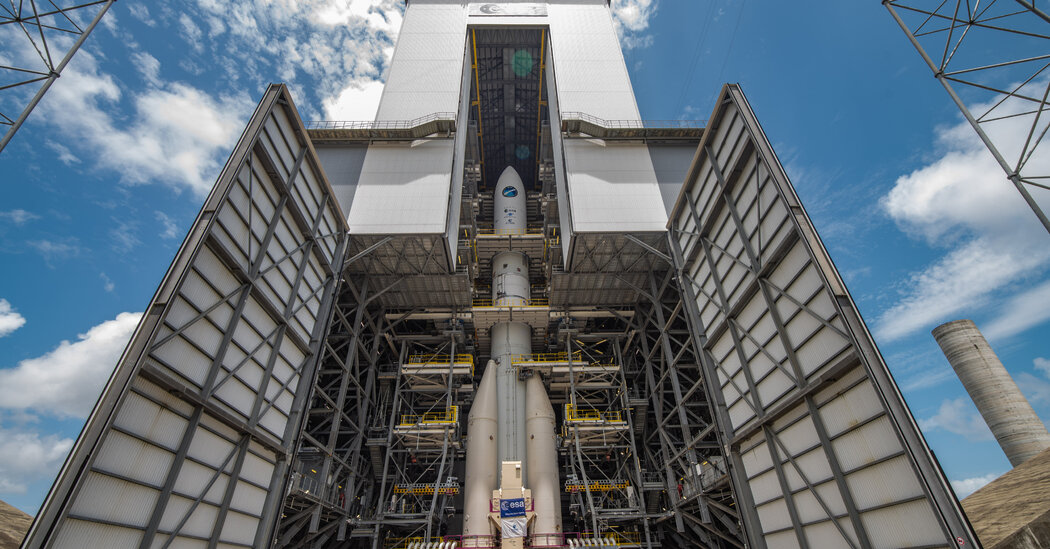The European Space Agency has waited about a decade for the first launch of Ariane 6, a powerful new rocket. But the brand-new vehicle is at last ready to fly — and if all goes well, European nations will once again have independent access to the final frontier, a crucial step for the space exploration and economic goals of the continent’s countries and companies.
Here’s what to know about the inaugural flight of the Ariane 6 heavy-lift launcher.
When will Ariane 6 launch, and how can I watch it?
Ariane 6 is scheduled to launch on Tuesday, July 9, from Europe’s Spaceport in Kourou, French Guiana, between 2 p.m. to 6 p.m. Eastern time.
ESA is streaming a live broadcast of the flight on YouTube, beginning at 1:30 p.m. Eastern time.
Why does Europe need its own rockets?
Europe has been without independent access to space since 2023, when Ariane 5, the vehicle that preceded Ariane 6, flew for the last time. Another smaller ESA rocket, Vega-C, has been grounded since 2022 because of a flight failure.
In the past, many of Europe’s missions flew on Russian Soyuz rockets. But Russia’s invasion of Ukraine led to a break in the relationship in 2022, ending Europe’s use of Russian launchers.
At the same time, Europe’s need to get to space — including for climate monitoring, navigation satellites and exploration of the moon, Mars and beyond — has only grown. For the past year, key missions by ESA have flown on SpaceX rockets, including the agency’s Earth Cloud Aerosol and Radiation Explorer, two Galileo navigation system satellites and the Euclid space telescope. Hera, an ESA spacecraft that will visit a pair of asteroids, is scheduled to be launched by SpaceX in the fall.
Rather than relying on international partners, a rocket built at home could guarantee that European missions, both institutional and commercial, will be prioritized on their own terms.
What is new about Ariane 6?
Built by Arianespace, a French aerospace company, Ariane 6 is the latest model in a family of rockets stretching back to the 1970s.
Compared with the now-retired Ariane 5, Ariane 6 comes with several improvements, like an upper stage powered by an engine that can be reignited up to four times. This makes it possible for missions requiring orbits of different altitudes to fly on a single rocket. The last boost can also be used to maneuver the upper stage out of orbit, where it will burn up in Earth’s atmosphere instead of contribute to the growing population of space junk.
The new rocket has a maximum height of 203 feet and comes in two versions. Ariane 62, with two boosters, has a maximum weight of 540 metric tons at liftoff and is capable of carrying payloads of up to 10.3 metric tons to low-Earth orbit. Ariane 64 has four boosters with a maximum weight of 870 metric tons at liftoff, and can carry up to 21.6 metric tons to low-Earth orbit.
The last version of Ariane 5, by contrast, could carry payloads of around 20 metric tons to low-Earth orbit, while SpaceX’s Falcon 9 can lift nearly 23 metric tons there.
On Tuesday, ESA is testing the capabilities of its two-booster model, Ariane 62.
What will launch on Ariane 6?
A suite of small missions from companies, government agencies and research institutions will head to space on Ariane 6’s first flight. Some of the spacecraft will be deployed into orbit around Earth, including NASA’s Cubesat Radio Interferometry Experiment, which will measure how solar radiation interacts with Earth’s atmosphere. Other payloads, like ESA’s Young Professionals Satellite, will remain on board and collect data during the flight.
Two re-entry capsules will also be released to demonstrate new technology that can race through Earth’s atmosphere and may someday bring back cargo from space.
What spacecraft will fly on Ariane 6 in the future?
Arianespace’s launch schedule for Ariane 6 is booked through mid-2028, with 30 flights planned for a variety of clients. This includes 18 launches for Project Kuiper, Amazon’s effort to build a space-based internet satellite constellation that will eventually rival SpaceX’s Starlink service.
If Tuesday’s launch is a success, another Ariane 6 rocket is expected to fly as early as December. Six more launches are scheduled for 2025; the next year, eight launches are planned, including ESA’s Plato mission, a space telescope that will hunt for exoplanets. Eventually, Arianespace hopes to maintain an average cadence of nine flights per year.
